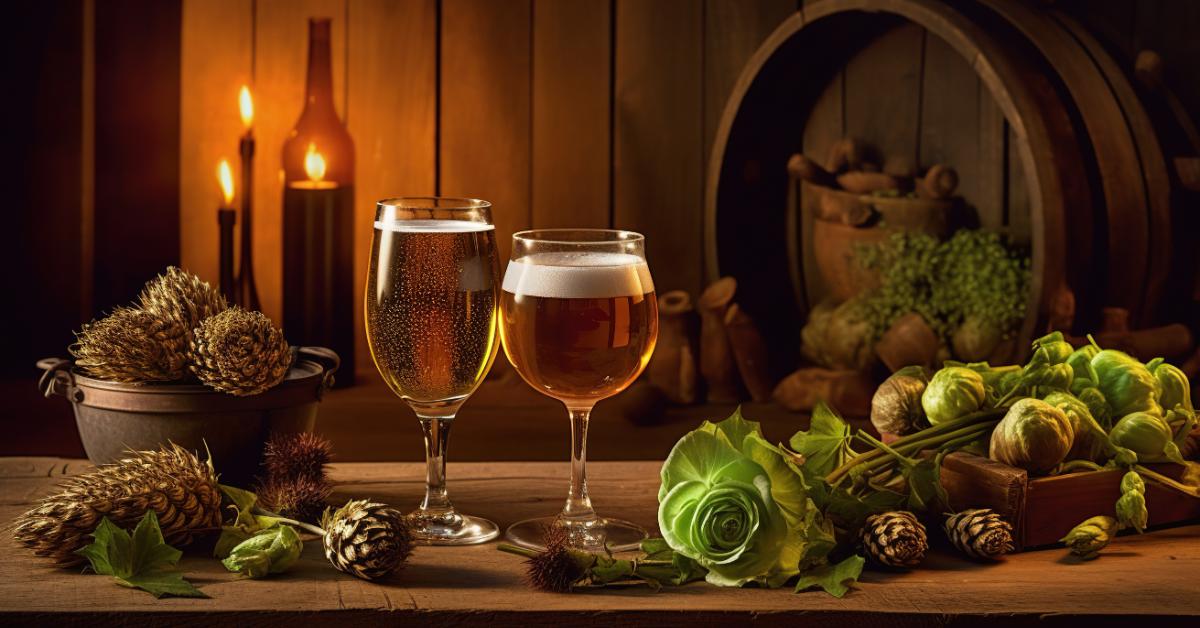In the enchanting realm of beers, Lambic ales hold a prestigious place, revered for their unique brewing process and unparalleled flavors. This comprehensive guide invites you on a journey to explore the mystique of Lambic ales, an exquisite Belgian beer that captivates the palates of enthusiasts worldwide. Let’s delve into the world of Lambic ales, uncovering their history, brewing process, varieties, and tips for enjoying this extraordinary beverage.
The Art of Brewing Lambic Ales
If you’ve never experienced it before, lambic is one of the world’s more unique styles of beer. It’s unique partly because of the amount of unmalted wheat (at least 30%) used to make this beer. What else helps make this beer unique is its wild fermentation.
Other ales and lagers are fermented with the same strain of yeast under scientifically controlled conditions. Lambic, on the other hand, is fermented with wild strains of yeast that are allowed to drift into the beer through open windows. As if that weren’t enough, lambic is hopped with old hops that have lost their bittering power.
Also Read
Lambic ales are more than just beer; they are a testament to a centuries-old brewing tradition that has remained largely unchanged since its inception in the Senne Valley, Belgium. What sets Lambic ales apart is their spontaneous fermentation process, a method that relies on the natural yeast and bacteria present in the air to ferment the beer. This unique approach imbues Lambic ales with a complex, sour, and often funky flavor profile that is both challenging and rewarding to the palate.
Brewed exclusively in the Pajottenland region and Brussels, Lambic ales are a reflection of their terroir, with each batch offering a distinct taste influenced by the specific conditions of its production. The traditional brewing process involves cooling the wort in open-air coolships, allowing the wild yeast and bacteria to initiate fermentation. This spontaneous fermentation is a slow, intricate process that can take months to start and years to mature, resulting in a beer that is a true labor of love and patience.
The Varieties of Lambic Ales
Again, unlike other beers, lambic is still fermented in wooden casks, each standing over nine feet tall at either end. Depending on the final product, lambic will rest in these casks for anywhere from four months to several years. On its own, young lambic will be honey-colored, low in carbonation, and fairly acidic. At the same time, lambic can be complex as well, with aromas of must, leather, and horse blanket. But lambic changes in character as it ages, bringing us to its two main styles: gueuze and fruit lambic.
Gueuze, at its most basic, is a mixture of young lambic and lambic that’s been allowed to age and mature for a few years.
Now, picture this for a moment. Old lambic, after years of maturation has completely fermented all its available sugars. Young lambic still retains some of its sugar and will continue fermenting, giving the beer an almost champagne-like carbonation.
Add to that the fact that each cask of lambic will attain its own character, and you’ve got a task not unlike the blending of wine or Scotch whiskey. Traditional gueuze will have a crisp, dry finish, although more commercial examples will have sugar added to sweeten the beer a bit. Beyond that, its character will depend very much on the producer.
Faro has, in large part, emerged as a concession to more common tastes. Like gueuze, Faro starts off as a blended beer, commonly a blend of lambic and another freshly brewed beer. To this, caramel sugars are added to sweeten the beer. Traditionally, the sugar is added before serving, resulting in a beer with lambic complexity and a sweetened finish. Faro can be hard to find outside of Belgium.
Fruit lambic is exactly what you might think it is. It’s a traditional lambic beer with fruit added during fermentation. These days, you can get lambic with many different fruits added, such as peach or grape. Traditionally, though, you would most often find cherry lambic referred to as kriek or raspberry lambic referred to as framboise. Fruit lambics usually come in between 5 and 7% abv. Kriek and framboise will be sharp and dry with great finish and depth. A well-made fruit lambic will be very much like a somewhat tart, dry, sparkling wine that happens to be able to hold a head. Fruit lambics are definitely not girly beers. They have too much depth and complexity for that.
Tips for Enjoying Lambic Ales
To fully appreciate the complexity of Lambic ales, a few tips can enhance your tasting experience. First, serve Lambic ales chilled but not cold, at around 50-55°F (10-13°C), to allow the full spectrum of flavors to emerge. Use a tulip-shaped glass to concentrate the aromas, taking the time to savor the bouquet before tasting.
When tasting Lambic ales, be mindful of the balance between sourness, sweetness, and bitterness. Allow the beer to linger on your palate, exploring the layers of flavor that unfold. Pairing Lambic ales with food can also elevate the experience. The acidity and fruitiness of these beers make them excellent companions to rich, fatty foods, balancing the palate and enhancing the flavors of both the beer and the dish.
What food pairs well with lambic?
Now, one of my favorite things about beer is how almost any beer style can be paired up with food. And lambic is no exception. Lambics are low in bitterness and high in acidity. This is what will drive your pairing. That acidity makes lambic a great pairing with seafood.
Lambic also pairs nicely with goat cheese, terrines, and sausages. Traditional fruit lambics are obviously great dessert beers. But it can go well with main courses as well.
Traditional kriek can be a wonderful companion to venison. A dry kriek or framboise marries perfectly with Mexican mole sauce. Kriek’s acidity and fruit flavors play really well with mole’s flavors of chocolate, nuts, and spices.
When it comes to dessert, sweet kriek or framboise marry with chocolate much in the way cherries go well in a black forest cake. But take my advice and avoid fruit lambic with fruit desserts. The flavors of fruit on fruit without any contrast will only serve to cancel each other out.
Lambic ales represent a pinnacle of brewing artistry, offering a unique window into the history and tradition of Belgian beer making. Their complex flavor profiles, born of ancient brewing techniques and spontaneous fermentation, challenge and delight those who seek them out. Whether you’re a seasoned beer aficionado or new to the world of craft beers, exploring Lambic ales is a journey worth taking.
Embark on this adventure with an open mind and palate, ready to experience the full range of what Lambic ales have to offer. From the tangy zest of a Gueuze to the sweet vibrancy of a Kriek, each sip is a testament to the craftsmanship and heritage of Belgian brewing. Lambic ales are not just beers; they are a celebration of nature, tradition, and the endless possibilities of fermentation. Discovering them is not merely about tasting beer—it’s about experiencing a piece of brewing history that continues to evolve and inspire.













